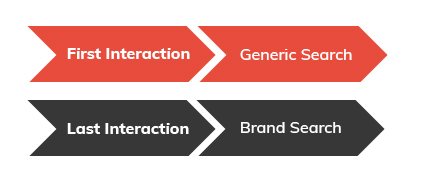Introduction
“What’s our best converting ad?” A question that is asked far too often in the agency business, and it’s a tough one to answer. Why? Well because up until now, the evolving digital landscape has made the user journey ever more complex, with a single user having multiple brand touchpoints across across display, video, search, and on your website or in your app. Not to mention the fact that these engagements are happening, at times simultaneously, across multiple devices. How are you to know what touchpoint was the real ‘decider’ in the purchase process?
This is where in-depth, data-driven attribution is key, and while marketers have been trying to make this work for a long time, many have fallen victim to the complex setups and cross device drop-offs, meaning that far too many marketing reports are falling back on last-click attribution to report their conversions.
What Is Data Driven Attribution?
To properly explain data driven attribution in Google Ads, I think it is important to begin by giving you a quick breakdown of attribution in general. Firstly, attribution in the marketing context relates to the process of assigning credit, or value to the various touchpoints a user has with your brand before purchasing.

Until now, attribution modelling in Google Ads has been fairly rule-based, in that there were a predefined set of processes that were undertaken in order to allocate which ad/campaign/spend contributed to the overall sale. You might have seen these, or used them, but at a glance they looked like this:
Last click: All the credit for the conversion goes to the last-clicked ad and keyword.
First click: All the credit for the conversion goes to the first-clicked ad and keyword.
Linear: Credit for the conversion equally distributed across all clicks on the path.
Time decay: Gives more credit to clicks that happened closer in time to the conversion. Credit is distributed using a 7-day half-life. In other words, a click 8 days before a conversion gets half as much credit as a click 1 day before a conversion.
Position-based: Gives 40% of credit to both the first- and last-clicked ads and corresponding keyword, with the remaining 20% spread out across the other clicks on the path.
Now, you might already be able to see problems with a lot of those models just by glancing at them, and this is why Google have put a lot of effort into building a more data-driven approach to how attribution is assigned.
Cue.. Data-Driven Attribution.

Data-driven attribution (DDA) is different to these other attribution models, in that it uses Google’s machine learning technology to determine exactly how much credit to assign to every bit of marketing spend that contributes to a conversion. While this is not necessarily a totally new technology (it was first introduced in 2016), it has come on leaps and bounds in the last 12 months, and is now the recommended model for all eligible search accounts.
Essentially, DDA is an attempt to take the guesswork out of choosing the right attribution model, which gives you more time to identify new strategic opportunities. Simply put, it delivers better results than the other models.
Why Getting It Right Is Important
The TL:DR version? Well it allows you to make more informed decisions about where your marketing budget is having the biggest impact.
As you know, very few people are searching with an “I know exactly what product i am going to buy” mentality. People are generally exposed to multiple ads, and for marketers, this means needing to know the value of each channel and interaction in the process. We see people fall into this trap all the time when it comes to seeing a large amount of ‘Direct’ traffic conversions, because by this point all the research has been done, and the conversion happens on a direct visit. This completely disregards all the hard work and budget that has gone into getting a customer to that point. This is the same reason that you should always take branded conversions with a pinch of salt. For example, in the image below, which of these would you give the credit to?

The debate on where the credit in this situation goes is one that fills forums and tweet threads, but regardless of your opinion in it, it seems a less than ideal solution to apportion all the credit to only one.
Ok, this all sounds great, how do I start?
Firstly, you need to make sure you are eligible. As mentioned earlier, this is available to search accounts that have a large enough data set for the algorithms to work from.
Because of this, not all advertisers will have the option for data-driven attribution available to them. As a general rule, in order to start with DDA, an account must have at least 15,000 clicks on Google Search and at least 600 conversions within the past 30 days.

To check if you are eligible, you can follow these steps:
- Sign in to your Google Ads account.
- Click the Tools tab and select Conversions.
- In the table, select the conversion action that you want to edit, then click Edit settings.
- Click ‘Attribution model’
If you see a yellow alert icon, this means that your account currently does not yet have data to enable data driven attribution.
If you are able to select DDA as an attribution model, you need to then ensure that your account data does not drop below 10,000 clicks for the account or 400 conversions for the conversion action within 30 days.

